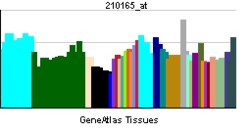
Deoxyribonuclease
A deoxyribonuclease (DNase, for short) is any enzyme that catalyzes the hydrolytic cleavage of phosphodiester linkages in the DNA backbone, thus degrading DNA. Deoxyribonucleases are one type of nuclease, a generic term for enzymes capable of hydrolyzing phosphodiester bonds that link nucleotides. A wide variety of deoxyribonucleases are known, which differ in their substrate specificities, chemical mechanisms, and biological functions.
Modes of action
Some DNases cut, or "cleave", only residues at the ends of DNA molecules (exodeoxyribonucleases, a type of exonuclease). Others cleave anywhere along the chain (endodeoxyribonucleases, a subset of endonucleases).
Some are fairly indiscriminate about the DNA sequence at which they cut, while others, including restriction enzymes, are very sequence-specific.
Some cleave only double-stranded DNA; others are specific for single-stranded molecules; and still others are active toward both.
DNase enzymes can be inhaled using a nebuliser by cystic fibrosis sufferers. DNase enzymes help because white blood cells accumulate in the mucus, and, when they break down, they release DNA, which adds to the 'stickiness' of the mucus. DNase enzymes break down the DNA, and the mucus is much easier to clear from the lungs.

Deoxyribonuclease I
Deoxyribonuclease I (usually called DNase I), is an endonuclease coded by the human gene DNASE1. DNase I is a nuclease that cleaves DNA preferentially at phosphodiester linkages adjacent to a pyrimidine nucleotide, yielding 5'-phosphate-terminated polynucleotides with a free hydroxyl group on position 3', on average producing tetranucleotides. It acts on single-stranded DNA, double-stranded DNA, and chromatin. In addition to its role as a waste-management endonuclease, it has been suggested to be one of the deoxyribonucleases responsible for DNA fragmentation during apoptosis.
DNase I binds to the cytoskeletal protein actin. It binds actin monomers with very high (sub-nanomolar) affinity and actin polymers with lower affinity. The function of this interaction is unclear. However, since actin-bound DNase I is enzymatically inactive, the DNase-actin complex might be a storage form of DNase I that prevents damage of the genetic information.
This gene encodes a member of the DNase family. This protein is stored in the zymogen granules of the nuclear envelope and functions by cleaving DNA in an endonucleolytic manner. At least six autosomal codominant alleles have been characterized, DNASE1*1 through DNASE1*6, and the sequence of DNASE1*2 represented in this record. Mutations in this gene, as well as factor inactivating its enzyme product, have been associated with systemic lupus erythematosus (SLE), an autoimmune disease. A recombinant form of this protein is used to treat one of the symptoms of cystic fibrosis by hydrolyzing the extracellular DNA in sputum and reducing its viscosity. Alternate transcriptional splice variants of this gene have been observed but have not been thoroughly characterized.
Podcasts:

-
by Donna Hughes
-
by Donna Hughes
-
by Die Hunns
-
by Die Hunns
-
by Die Hunns
-
by Die Hunns
-
by Die Hunns
-
by Die Hunns
-
by Die Hunns
-
by Die Hunns
-
by Die Hunns
-
by Die Hunns
-
by Die Hunns
-
by Die Hunns
-
by Die Hunns
-
by Die Hunns
-
by Die Hunns
-
by Die Hunns
-
by Die Hunns
-
by Die Hunns
-
by Die Hunns
-
by Twinz
-
by Twinz
-
by Twinz
-
by Twinz
-
by Twinz
-
by Twinz
-
by Twinz
-
by Twinz
-
by Twinz
-
by Twinz
-
by Twinz
-
by Teens
-
by Teens
-
by Teens
-
by Teens
-
by Teens
-
by Teens
-
by Twins
-
by Twins
-
by Twins
-
by Twins
-
by Twins
-
by Twins
-
by Tennis
-
by Tennis
-
by Tennis
-
by Tennis
-
by Tennis
A Dream
by: Donna HughesYou placed your hand in mine
And I saw you smile
We walked for a while
Until the sun disappeared behind
I love to hear you sing
The way you laugh at me
We sat in that old swing,
And you say you'll never leave
Chorus: Then I woke up, It was just a dream
You are not here, I think I'll go right back to sleep
You looked so real to me
You made me believe
That I was all you'd need
And you set my poor heart free
You told me you were mine
We left the past behind
No more lonely nights and
I was happy for a while
Latest News for: dnase
- 1

